I still remember the day I stood in front of the mirror, drained and disconnected from the woman staring back. I wasn’t chasing perfection—I just wanted to feel good again. So I stepped into my kitchen, not to count calories, but to reconnect with food that heals.
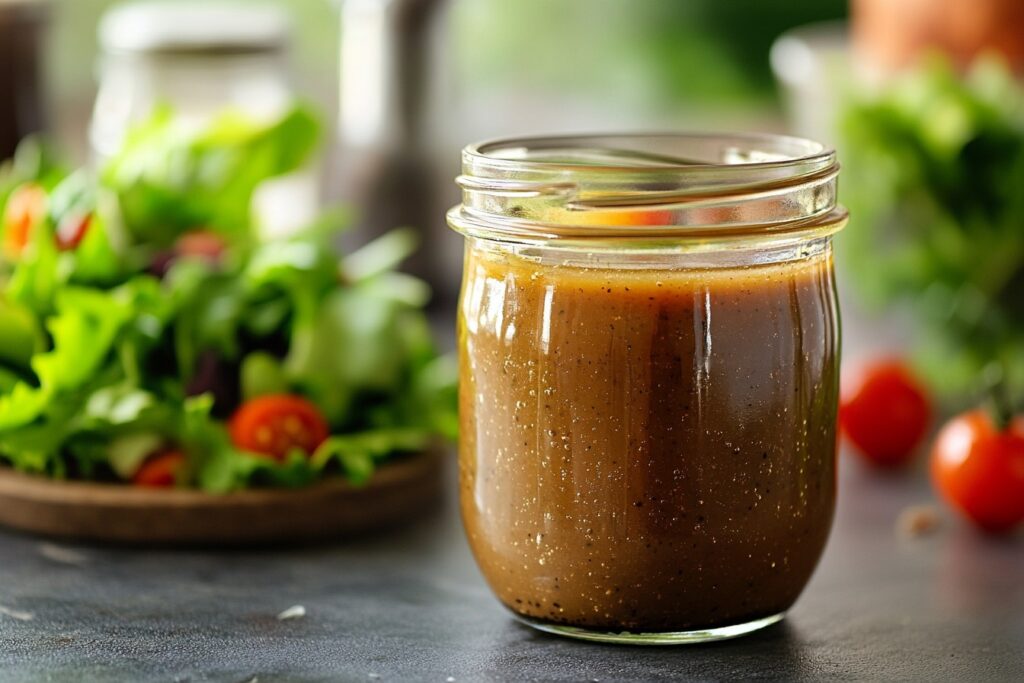
That’s where this balsamic creamy salad dressing comes in. It’s more than a recipe—it’s one of the first things I made that helped me fall in love with healthy eating again. Creamy, tangy, and full of bold flavor, it turns even the simplest salad into something comforting and crave-worthy. Let’s make it together.
Table of Contents
Table of Contents
What is Balsamic Creamy Salad Dressing?
Understanding the Flavor Profile
Balsamic creamy salad dressing combines the bold acidity of balsamic vinegar with rich, smooth elements like mayo, yogurt, or sour cream. The result? A balanced, tangy dressing with a velvety finish. It’s slightly sweet, a bit zesty, and entirely crave-worthy. This dressing’s complexity makes it suitable for everything from leafy greens to grain bowls.
Balsamic vinegar’s natural sweetness, which comes from reduced grape must, makes it the star of the show. Paired with a creamy base, it transforms from sharp to luscious without losing that kick of flavor.
What Makes It Different from Regular Vinaigrettes
A traditional vinaigrette is typically made with just oil and vinegar — it’s light and acidic. But balsamic creamy salad dressing steps things up by incorporating creamier ingredients that mellow out the tang and add body. Unlike vinaigrettes, which separate easily, the creamy version has better emulsification, meaning it stays blended and clings to your salad better.
Here’s a quick comparison:
| Feature | Vinaigrette | Creamy Balsamic |
|---|---|---|
| Texture | Thin, separates | Thick, stays blended |
| Main Base | Oil + Vinegar | Mayo, Yogurt + Balsamic |
| Flavor | Sharp, acidic | Smooth, tangy-sweet |
| Uses | Light greens | Hearty salads, wraps, bowls |
Creamy versions are especially great for people who find regular vinaigrettes too sour or watery. They offer a more luxurious mouthfeel and more versatile usage.
Print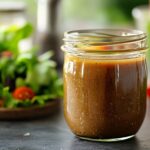
Balsamic Creamy Salad Dressing
- Total Time: 5 minutes
- Yield: 6
Description
A rich, tangy, and smooth balsamic creamy salad dressing made with Greek yogurt or mayo, balsamic vinegar, Dijon mustard, and garlic. Quick to make, easy to customize, and perfect for salads, grain bowls, and more.
Ingredients
- 3 tablespoons balsamic vinegar
- ½ cup Greek yogurt (or mayonnaise, or 50/50 blend)
- 1 tablespoon Dijon mustard
- 1 tablespoon olive oil
- 1 teaspoon honey (optional)
- 1 garlic clove, finely minced
- Salt and freshly ground black pepper to taste
Instructions
- In a medium mixing bowl, add Greek yogurt (or mayo) and let it sit at room temperature for a few minutes.
- Slowly whisk in the balsamic vinegar to avoid curdling.
- Add mustard, olive oil, minced garlic, and honey. Whisk until creamy and fully combined.
- Season with salt and pepper to taste.
- Store in a sealed jar and refrigerate for at least 30 minutes before serving.
Notes
For a vegan version, swap the yogurt or mayo with blended silken tofu or cashew cream.
Add 1 tsp Italian herbs or chili flakes for flavor variation.
Dressing thickens slightly after refrigeration—whisk or thin with a splash of water if needed.
- Prep Time: 5 minutes
- Cook Time: 0 minutes
- Category: Healthy Recipe
- Cuisine: American
Key Ingredients in Balsamic Creamy Salad Dressing
Creamy Components: Yogurt, Mayo, or Cream
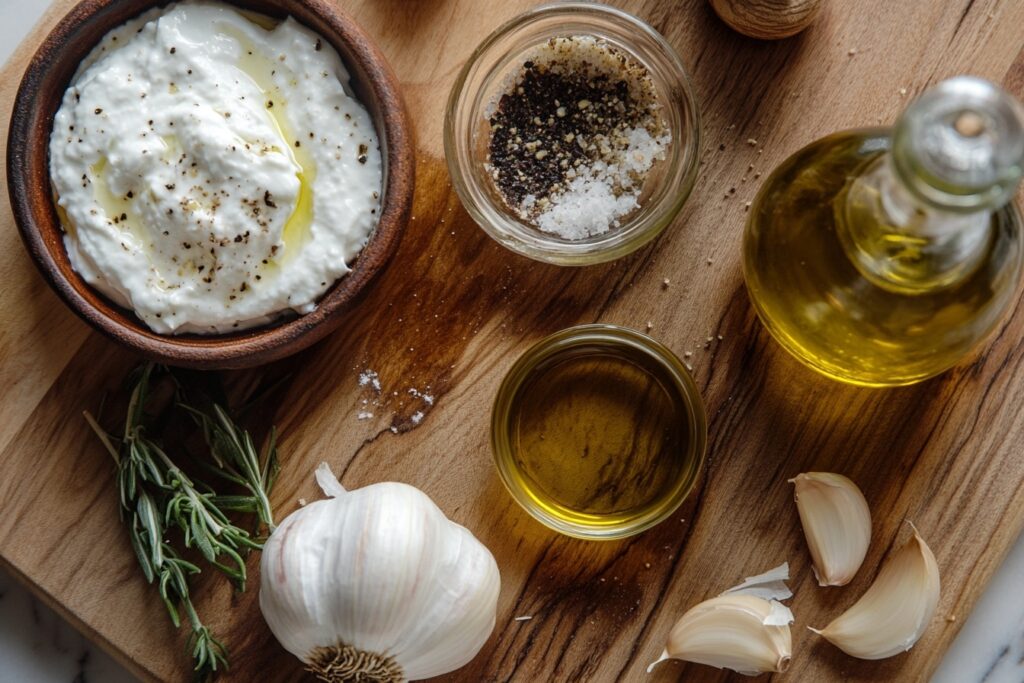
The heart of any balsamic creamy salad dressing lies in its rich, velvety texture. That creamy base can come from a variety of ingredients—each offering its own twist:
- Greek yogurt delivers tang, protein, and a lighter calorie profile.
- Mayonnaise creates a richer, more indulgent mouthfeel that clings beautifully to greens.
- Sour cream or heavy cream adds a smooth, full-bodied finish perfect for hearty salads.
Choosing your base depends on what you’re after: a healthier version, a keto-friendly one, or pure decadence. You can even combine them for balance, like using half mayo, half yogurt.
Balsamic Vinegar and Its Role
Balsamic vinegar isn’t just the flavor—it’s the soul of this dressing. Made from concentrated grape must, it brings a rich tanginess with natural sweetness. Aged varieties add deeper, molasses-like undertones.
In a creamy mix, balsamic cuts through the richness, bringing brightness and depth. It’s essential for that sweet-tart balance that keeps this dressing from tasting flat.
Pro tip: Use a high-quality balsamic vinegar for a smoother, more complex flavor.
Optional Add-ins for Flavor Boosting
Once you’ve got your creamy base and balsamic set, the fun begins. Here’s where you can personalize your dressing and take it to the next level:
- Dijon mustard – Adds a slight bite and helps with emulsification.
- Honey or maple syrup – Balances acidity with a touch of natural sweetness.
- Minced garlic or shallots – Brings boldness and complexity.
- Herbs like basil, thyme, or oregano – For a Mediterranean flair.
- Cracked black pepper or red chili flakes – Add depth or a bit of heat.
Just a few tweaks can turn one recipe into endless variations, all centered on that perfect blend of creamy and balsamic.
Discover great ideas like this Healthy Balsamic Vinaigrette Recipe if you’re curious about the lighter side of balsamic.
Can You Mix Balsamic with Cream or Mayo?
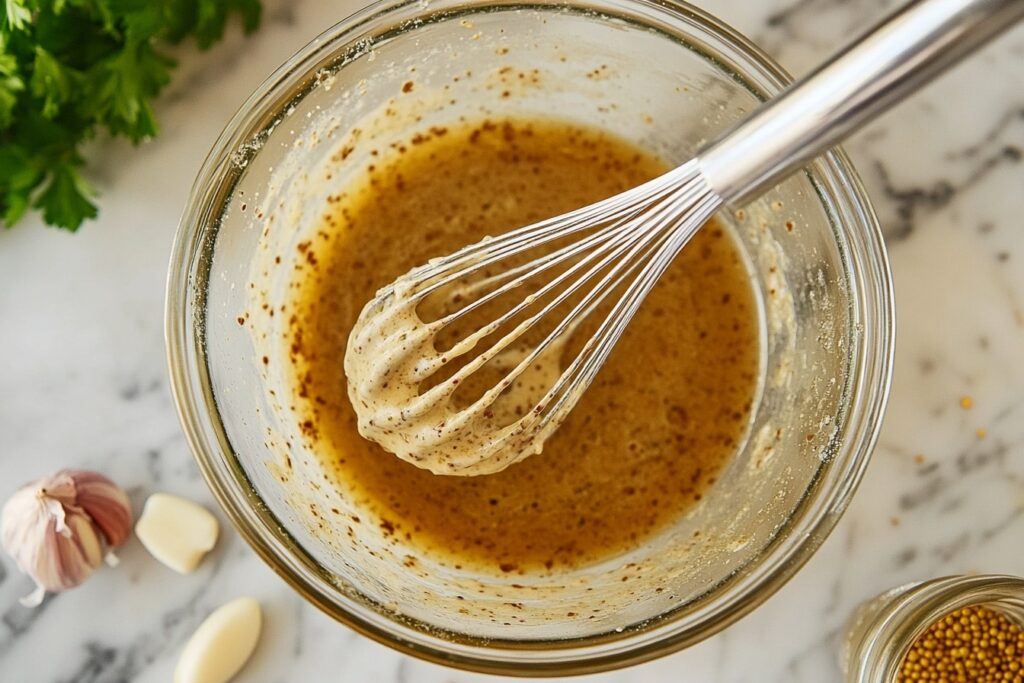
The Science Behind Mixing Acid with Dairy
At first glance, mixing something as tangy and acidic as balsamic vinegar with creamy elements like mayo or yogurt might seem like a recipe for disaster. Won’t it curdle? Surprisingly, when done right, the combination results in a smooth, velvety texture that elevates any salad.
Here’s why it works:
- Mayonnaise is an emulsion—meaning oil and egg are already stabilized. Adding balsamic vinegar simply deepens the flavor without breaking the texture.
- Greek yogurt or sour cream, being thicker and cultured, can handle acidic ingredients better than milk or cream. You’ll get a slightly tangy base with a balanced finish.
Still, there’s a method to making it work. To avoid separation or curdling:
- Add the balsamic slowly while whisking continuously.
- Let creamy ingredients come to room temperature before mixing.
- Consider adding a stabilizer like mustard or honey, which helps bind the dressing.
Common Pitfalls and Fixes When Emulsifying
Even the best home chefs can run into issues when blending cream and vinegar. Here’s a quick guide to fix or avoid the most common mistakes:
| Problem | What’s Happening | How to Fix It |
|---|---|---|
| Dressing separates | Emulsion has broken | Add a spoon of Dijon mustard and re-whisk |
| Texture is grainy | Vinegar added too fast | Whisk slowly and add balsamic gradually |
| Dressing curdles | Dairy too cold or balsamic too sharp | Use full-fat yogurt/mayo and let both sit at room temp |
Don’t let one misstep scare you off. Once you get the hang of it, mixing balsamic and mayo or yogurt becomes a go-to move for quick, flavorful dressings.
Check out this tip-filled About Me page where I share how small recipes like this one started a big lifestyle change for me.
Step-by-Step Homemade Balsamic Creamy Salad Dressing Recipe
Simple Ingredients You’ll Need
Making your own balsamic creamy salad dressing at home doesn’t require fancy ingredients. In fact, you probably have most of these on hand already. Here’s what you’ll need:
Base Ingredients:
- 3 tablespoons balsamic vinegar (high quality)
- ½ cup plain Greek yogurt (or mayo, or a 50/50 blend)
- 1 tablespoon Dijon mustard
- 1 tablespoon olive oil
- 1 teaspoon honey (optional for sweetness)
- 1 garlic clove, finely minced
- Salt and freshly ground black pepper to taste
Optional Add-ins:
- 1 teaspoon fresh thyme or dried Italian herbs
- 1 tablespoon finely chopped shallots
- Dash of red chili flakes (for a little heat)
This ingredient combo creates a perfect harmony of tang, richness, and creaminess. It’s low in sugar, packed with flavor, and easy to customize.
Instructions for Perfect Emulsion and Texture
This dressing comes together in less than 5 minutes. Here’s how to make it smooth, creamy, and restaurant-worthy:
- Start with the creamy base
In a medium bowl, add the Greek yogurt (or mayo). Let it sit out for a few minutes to reach room temperature—this prevents curdling when the vinegar hits. - Whisk in the balsamic vinegar slowly
While whisking constantly, drizzle in the balsamic vinegar. This step is key to building the emulsion and avoiding separation. - Add flavor builders
Mix in the mustard, olive oil, garlic, and honey. Continue whisking until everything is fully combined and silky. - Season and adjust
Add salt and pepper to taste. If it’s too thick, thin it out with a splash of water or milk (about 1 teaspoon at a time). - Optional flavor twists
Stir in herbs, shallots, or chili flakes if desired. Taste and adjust until it hits just the right balance for you. - Store and chill
Pour into a jar with a tight lid. Refrigerate for at least 30 minutes before serving to let the flavors meld.
Don’t miss our Healthy Balsamic Vinaigrette Recipe for a lighter, oil-based version of this classic.
Health Benefits of Balsamic Creamy Dressings
Low-Carb and Keto Options
Many store-bought creamy dressings are loaded with hidden sugars, artificial thickeners, and unhealthy fats. When you make your own balsamic creamy salad dressing at home, you get complete control over what goes in — making it easy to keep things clean, fresh, and even keto-friendly.
Here’s how it fits into low-carb lifestyles:
- Greek yogurt or full-fat mayo provides healthy fats and protein with minimal carbs.
- Balsamic vinegar, when used in moderation, adds flavor without significant sugar.
- No added preservatives or cornstarch keeps the carb count down.
For a strict keto version, skip the honey and use olive oil with full-fat mayo instead.
Nutritional Snapshot (Per Serving – 2 tbsp):
| Nutrient | Approx. Value |
|---|---|
| Calories | 80–100 kcal |
| Total Fat | 8–9g |
| Protein | 1–2g |
| Net Carbs | 1–2g |
By skipping the bottled stuff and choosing real ingredients, you’re feeding your body with flavor and function—without the crash from added sugars or processed oils.
Balsamic vinegar is rich in polyphenols that support heart health and may help regulate blood sugar. Explore more in this health analysis from Healthline.
Heart-Healthy Ingredients to Include
Making your own dressing means you can pack it with ingredients that support cardiovascular health:
- Olive oil: Rich in monounsaturated fats that support heart health and reduce inflammation.
- Garlic: Known to lower blood pressure and improve cholesterol levels.
- Yogurt: Contains probiotics for gut health and protein for muscle support.
- Balsamic vinegar: Full of polyphenols that may reduce blood pressure and boost blood flow.
Pairing this dressing with leafy greens, tomatoes, and healthy protein makes for a balanced meal that truly fuels your body.
Looking for inspiration? Try our Healthy Balsamic Vinaigrette Recipe to switch things up with a lighter base.
Best Ways to Use Balsamic Creamy Dressing
Salad Combos That Match the Dressing
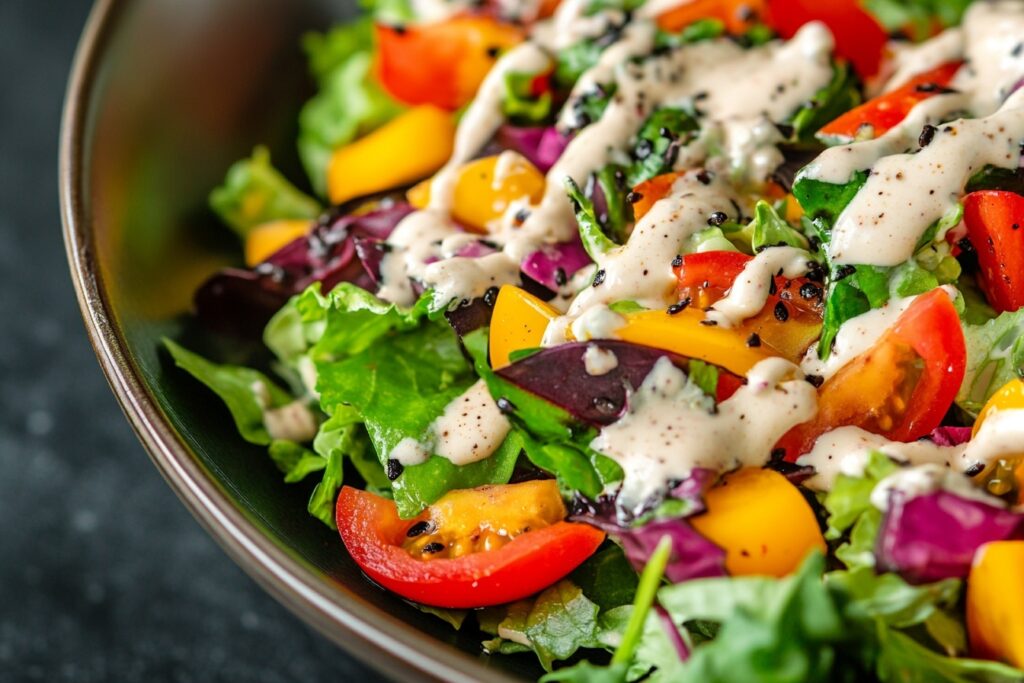
Balsamic creamy salad dressing shines on more than just leafy greens — it’s a versatile staple that complements a wide range of salad styles. Its thick texture and balanced tang make it ideal for hearty ingredients and bold flavors.
Here are some salad combinations that pair beautifully:
| Salad Type | Best Ingredients to Pair |
|---|---|
| Chicken Caesar Remix | Grilled chicken, romaine, cherry tomatoes, parmesan |
| Mediterranean Bowl | Quinoa, cucumbers, feta, olives, red onion |
| Roasted Veggie Salad | Sweet potatoes, kale, cranberries, pumpkin seeds |
| Steak & Spinach | Sliced sirloin, baby spinach, blue cheese, red peppers |
The creaminess of the dressing softens bitter greens like arugula and collards, while the tang of balsamic balances sweeter elements like roasted squash or beets.
Don’t miss our other clean-eating combos over on the Healthy Recipe World homepage.
Other Creative Uses: Grains, Bowls, Wraps
Think beyond salad. This balsamic creamy salad dressing also works wonders in:
- Grain bowls: Drizzle it over brown rice, farro, or quinoa bowls packed with veggies and protein.
- Sandwich spreads: Use it as a tangy mayo substitute on wraps or grilled paninis.
- Veggie dip: Serve as a thick dip with bell peppers, carrots, or roasted cauliflower.
- Marinade: Use it to marinate chicken or tofu for a bold, flavorful finish.
Because this dressing walks the line between zesty and smooth, it adapts easily to both savory and slightly sweet dishes.
Check out our About Me story to see how creative meals like these helped me stay excited about healthy eating.
Storage, Shelf Life, and Meal Prep Tips
How to Store and Keep It Fresh
Once you’ve crafted the perfect balsamic creamy salad dressing, keeping it fresh is key to enjoying it all week long. Since this dressing contains dairy or egg-based ingredients like Greek yogurt or mayo, proper storage is non-negotiable.
Here’s how to do it right:
- Use an airtight glass jar or a salad dressing bottle with a tight seal. Avoid plastic if possible to preserve flavor.
- Label it with the date you made it.
- Refrigerate immediately after preparing. It needs to stay cold to avoid spoilage.
- Before each use, give it a good shake or stir, especially if it’s been sitting for more than a day.
Shelf Life Tip:
When stored properly, homemade balsamic creamy salad dressing will stay fresh for 5–7 days. If it starts to smell sour or separate excessively, it’s time to make a new batch.
Batch Making Tips for Weekly Meal Prep
Meal prepping with balsamic creamy salad dressing makes it easy to throw together quick, nutritious meals all week. Here are smart ways to build it into your routine:
- Double the recipe and divide it between two small containers—one for home, one for work.
- Prep dressing alongside pre-chopped veggies or pre-cooked proteins for a ready-to-assemble salad kit.
- Use it as a base for two variations: one with herbs, one with garlic and chili, for flavor variety.
- Add a spoonful to grain bowls or wraps to switch things up without extra prep.
Looking for inspiration? Try our Healthy Balsamic Vinaigrette Recipe — perfect for prepping lighter salads when creamy isn’t the vibe.
By prepping ahead, you save time, reduce waste, and ensure you always have a delicious, nutrient-packed option ready to go.
Comparing Store-Bought vs. Homemade Versions
Nutritional Label Breakdown
The convenience of store-bought balsamic creamy salad dressing is tempting—but when you flip over that bottle and check the label, things can get sketchy fast. Many commercial dressings contain:
- Added sugars (often hidden under names like “high fructose corn syrup” or “dextrose”)
- Artificial thickeners like xanthan gum or carrageenan
- Low-quality oils (such as soybean or canola)
- Excess sodium and preservatives
Let’s break it down side by side:
| Factor | Store-Bought | Homemade |
|---|---|---|
| Sugar Content | 3–7g per 2 tbsp | 0–2g (you control it) |
| Fat Source | Often processed oils | Olive oil, yogurt, or mayo |
| Additives | Yes (preservatives, gums) | None |
| Cost per Serving | ~$0.60 | ~$0.25 |
| Flavor Control | Fixed | Fully customizable |
When you make your own balsamic creamy salad dressing, you’re choosing real ingredients and skipping the extras your body doesn’t need.
Additives and Preservatives to Watch Out For
Here are a few common additives to avoid in commercial dressings:
- Monosodium glutamate (MSG) – Linked to headaches and bloating in sensitive individuals
- Titanium dioxide – Sometimes used to brighten color
- Sodium benzoate – A preservative that may impact gut health
- Artificial “natural” flavors – Often derived from non-food sources
The homemade version not only wins on flavor and nutrition—it also aligns with your wellness goals. It’s cleaner, fresher, and tailored to your taste.
Discover great ideas like this Healthy Balsamic Vinaigrette Recipe if you’re aiming to ditch commercial dressings altogether.
Creative Twists on the Classic Balsamic Creamy Dressing
Adding Herbs, Mustard, Garlic, or Honey
One of the best things about making your own balsamic creamy salad dressing is how customizable it is. Once you’ve got the base recipe down, small tweaks can dramatically change the flavor and elevate your meals.
Here are some popular variations to try:
- Garlic Herb Version: Add 1 teaspoon of fresh minced garlic and a tablespoon of finely chopped parsley or basil. This pairs great with Italian-style salads.
- Spicy Dijon Balsamic: Mix in 1 tablespoon Dijon mustard and a pinch of crushed red pepper flakes. It adds kick and depth without overpowering the creamy base.
- Sweet & Tangy Honey Blend: For a slightly sweeter take, add 1–2 teaspoons of honey or maple syrup. Great with grilled chicken or roasted veggie salads.
- Zesty Lemon & Thyme: A splash of lemon juice and a pinch of fresh thyme brighten the dressing and cut through richness.
These easy twists don’t require additional prep—just stir in the extra ingredients and taste as you go. It’s the perfect way to keep things exciting without starting from scratch every time.
Regional Variations and Flavor Experiments
Want to get even more creative with your balsamic creamy salad dressing? Try these inspired regional spins:
- Mediterranean Style: Add feta crumbles, a bit of oregano, and chopped olives for a briny, creamy dressing.
- Tex-Mex Inspired: Use chipotle powder, lime juice, and a touch of Greek yogurt for a smoky, spicy version.
- Asian Fusion: Sub part of the balsamic with rice vinegar and add a drop of sesame oil and grated ginger for a tangy-umami twist.
- Vegan Option: Replace mayo/yogurt with blended silken tofu or soaked cashews for a plant-based version with similar creaminess.
Experimenting with global flavors allows you to tailor your dressing to any cuisine or craving, all while sticking with your nutritious homemade base.
Looking for more dressing inspiration? Visit the Healthy Recipe World homepage to explore new healthy twists and meal ideas.
FAQs About Balsamic Creamy Salad Dressing
What is in creamy balsamic dressing?
Creamy balsamic salad dressing typically includes balsamic vinegar, a creamy base (like Greek yogurt, mayonnaise, or sour cream), Dijon mustard, olive oil, garlic, salt, and pepper. Optional add-ins include honey, herbs, or shallots. These ingredients blend into a rich, tangy, and slightly sweet dressing that pairs perfectly with salads and grain bowls.
Can you mix balsamic vinegar and cream?
Yes, you can mix balsamic vinegar with cream-based ingredients like yogurt, sour cream, or mayo. The key is to add the vinegar slowly and mix well to avoid curdling. The acidity of balsamic vinegar cuts through the richness of the cream, resulting in a balanced and flavorful balsamic creamy salad dressing.
Can you mix balsamic and mayo?
Absolutely. In fact, mayo is one of the most common ingredients in balsamic creamy salad dressing. It helps emulsify the vinegar and provides a smooth, rich base. When combined properly, it creates a velvety dressing that clings beautifully to greens and other ingredients.
How to make a salad dressing with balsamic vinegar?
To make a simple balsamic creamy salad dressing, whisk together:
3 tbsp balsamic vinegar
½ cup Greek yogurt or mayo
1 tbsp Dijon mustard
1 tbsp olive oil
1 clove garlic (minced)
Salt and pepper to taste
Combine the ingredients until smooth and creamy. Adjust seasoning and thickness as desired. You can also add honey for sweetness or herbs for extra flavor.
Conclusion
Making your own balsamic creamy salad dressing is one of the easiest and most rewarding ways to upgrade your meals. With just a handful of real ingredients and a few minutes in the kitchen, you can create a dressing that’s rich, tangy, and tailored to your taste.
Whether you’re drizzling it over greens, using it as a dip, or mixing it into grain bowls, this creamy blend brings both comfort and nutrition to your plate. Skip the bottled stuff—homemade gives you better flavor, cleaner ingredients, and full creative control.
Don’t miss our Healthy Balsamic Vinaigrette Recipe if you’re looking for a lighter variation to mix things up!
